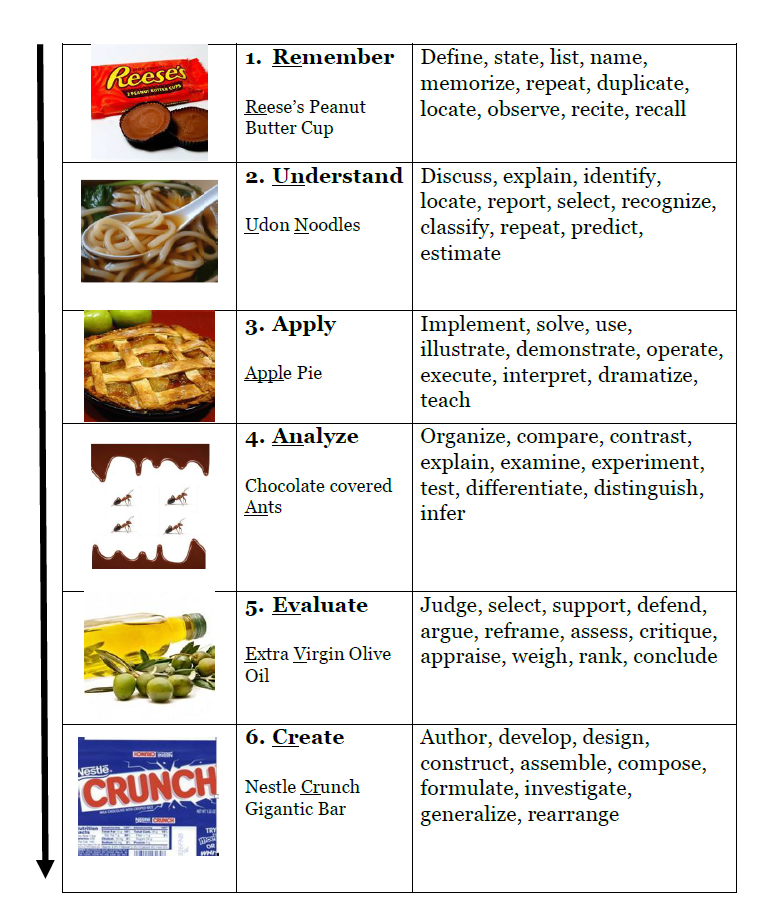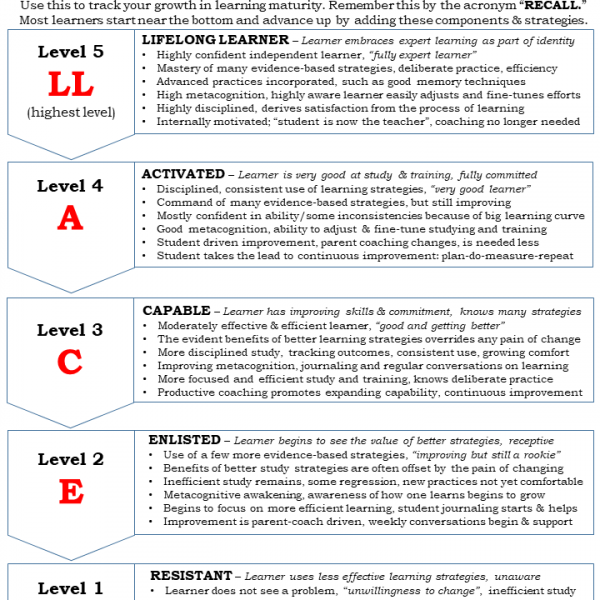
How to Memorize Bloom’s Taxonomy

Reading time: 10 minutes
The Teach UP technique means identifying the level of thinking your child is at on any given subject matter, and then coaxing a higher level of thinking by providing more information and then conducting learning activities the next level up on the pyramid.
 You may wish to memorize the six levels of the thinking so you can use the taxonomy without having to look it up – try this kitchen mnemonic which gives you a way to “think on your feet” while teaching.
You may wish to memorize the six levels of the thinking so you can use the taxonomy without having to look it up – try this kitchen mnemonic which gives you a way to “think on your feet” while teaching.
More powerful teaching uses the six levels to guide your selection of the appropriate learning activities to promote better learning and deeper thinking.
To help you remember the six levels, I will guide you on a Mnemonic journey through your kitchen to explore the six thinking levels from bottom to top. You can make this fun while you learn how to recall each level as a food item.
When we use images to remember things, we should try to picture the image as a video, not a still image, and we also want to combine this video with at least one more of our senses. These two actions will greatly enhance your recall. For example, at the first level of thinking “Remember” you need to create a little video in your mind where you interact with the peanut butter cup in your kitchen. Don’t just imagine a static picture of the cup, you need to pick it up and the taste the peanut butter cup! Interactivity and the use of multiple senses are necessary to anchor it to memory. The familiarity of your kitchen provides a useful link to your memory, which benefits recalling this information. The more senses you involve, the better you tie each item to existing memory. For each food – try to see it, touch it, smell it, taste it.
Exaggeration and the use of outlandish images will help you remember. Don’t resist doing this because it seems silly. The idea is to create something, that if this really happened to you, you would never forget it.
As you read this story, project yourself into the situation, and associate each food image with the level of thinking it represents. Try to make your journey as real as possible by making each a “movie in your mind.” Read – close your eyes – imagine it. Let’s do it!
Imagine these Six Foods in Your Kitchen
To begin this exercise, imagine you walk into your kitchen. Picture your kitchen and use this vivid imagine each object and connect it to a level in Bloom. This uses the “linking method” to help you remember each level in sequence.
ONE: On the counter, you are surprised to see a Reese’s peanut butter cup in its orange wrapper and yellow letters. You are very hungry, so you tear it open and take a big fat luscious bite. Reese’s provide the first two letters to the first level of “RE member.” The first level of our taxonomy is sweet and chocolatey. Picture it, taste it, and try adding another sense where you feel a little sticky chocolate stuck to your 2nd and 3rd fingers! Reese’s Peanut Butter Cups = Remember.
Stop reading for a moment and take time to play this video in your mind.
TWO: After you finish the Reese’s, you realize you are still hungry, and you now desire something savory. You look to another counter in your kitchen, and you are surprised because someone has fixed you a big hot steaming bowl of fat Chinese Udon noodles! Yum! Smell the savory steam coming off the bowl. Picture some of your favorite veggies in it with big spoon in the bowl just waiting for you to pick it up. The first letters of each word of Udon Noodles stand for the second level of thinking – UN derstanding.
If this image does not resonate with you pick another food that has the two letters – Unagi or a U-No candy bar. You must find something you connect to and will remember. But still follow the rule of engaging several of your senses. Udon = Understand.
Again, stop reading, close your eyes, and create a video in your mind.
THREE: Now for the next level. After taking a few bites of the savory soup, you now crave something sweet! Now you notice a familiar smell, turn around, and behold –someone has made you a fresh homemade hot apple pie! Bless their heart! It’s right there on the counter and it looks amazing. Smell it. O-h-h-h-h yum! You take a bite and then you notice the taste of the fresh apples feels so luxurious, and you can also feel the flaky texture of the crust! Apple Pie = Apply. You got it!
You might be thinking – this is not only weird but highly unusual. Does it seem like no one ever cooks for you? How lucky you are today!
FOUR: But your luck is about to change as you continue the kitchen journey, it’s going to get a little gross, but that’s OK, as the more vivid you make this you will never forget the 4th level.
After pie, you somehow still crave something sweet. Next, look what this mysterious person has prepared for you– chocolate-covered ants! There’s a plate with four exceptionally large ones artfully arranged in a symmetrical pattern sitting right over there on your kitchen table. Yuk. But – go ahead walk over and pick one up. You feel how strange these tiny little bites look – even the little antlers are dipped in dark chocolate. Keep in mind the principle of imagination – the more vivid you make it – the better. Maybe you take a bite – or – maybe not. You think – “How can anyone eat this?” This becomes our 4th level of thinking. Chocolate Covered Ants lying on a plate = Analyze.
 If you can’t relate to this image, then you will need to substitute something else. For example, try Robert DeNiro in the 1999 movie “Analyze This.” If this works, picture him in his suit walking into your kitchen and picking up a piece of the apple pie, it’s dripping on his sleeve, then have him reach over and pour olive oil on the stain to wash it off. You have now linked the pie with the next item on the taxonomy.
If you can’t relate to this image, then you will need to substitute something else. For example, try Robert DeNiro in the 1999 movie “Analyze This.” If this works, picture him in his suit walking into your kitchen and picking up a piece of the apple pie, it’s dripping on his sleeve, then have him reach over and pour olive oil on the stain to wash it off. You have now linked the pie with the next item on the taxonomy.
Stop and create this video in your mind.
FIVE: So, you disgustingly put down that remaining half of the little critter and you move on. Yuk. (Sorry I had to do one thing gross, so you get the concept of exaggeration and gross images). You are now ready to find something healthy and normal that you really might want to eat later. The mysterious cook has left another gift for you. You notice a nice bottle of extra virgin olive oil. Find your favorite kind and a place where you picture it sitting – maybe it’s sitting on your wooden cutting board. But it’s not any kind of oil, because you likely won’t remember that – it has to be something incredibly special for you – it’s extra virgin! So, picture a big fancy and expensive bottle of extra virgin olive oil (maybe with a little Italian flag on it) – it has to be memorable! Extra Virgin Olive Oil = Evaluate
If you have a favorite olive oil, incorporate it into your video to make it more real.
SIX: Last one. This is the highest level of thinking. You are almost at the end of your kitchen journey. It’s time for some dessert! You look around and someone has left you a Nestle Crunch candy bar! But not an ordinary one, it’s the whopping gigantic size! It’s two feet across and weighs 10 pounds! Imagine yourself straining to lift it with both hands. It’s not any candy bar – it’s the Crunch with the red letters and the blue and white wrapper. You need another sense to remember it – maybe you feel the bumps underneath the wrapper. Perhaps you open it and take a bite – remember the taste. But uh-oh, it’s the super big size – maybe you should hide it from the kids! After all, this is your reward for this journey. You are at the top of the taxonomy pyramid.
Nestle Crunch = Create.
That’s too many sweets in one day, I hope you don’t have indigestion. You now have six images you want to keep linked together, so each one connects to the next.
After finishing your video of your mind, you can stop the exercise.
To help you start the transfer of this into long-term memory, you will want to review what you just created. Go back and without looking, revisit your kitchen journey videos. Include all your sensory experiences. Do this several times and it will become a tool you can quickly recall. To help you add this to your memory – you start and end with candy. Review it several times today, and several times tomorrow, and you will have started to establish it into your long-term memory.
Now you have a way to recall Bloom’s Taxonomy whenever you need it for your homeschooling! Using Bloom will help you be a better and more confident instructor.
Bloom’s Quick Reference Memory Chart
This chart inverts Bloom’s pyramid – you start your memory journey at the lowest level of thinking, which is at the bottom of the pyramid.







